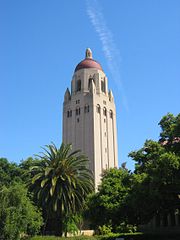Illumina ($ILMN) is a company that has become used to success. Over the past year its share price has soared 180% as it has established a dominant position in what is potentially a $20 billion market. Yet this week a collaboration between Illumina and The Scripps Research Institute lost to a Stanford University-led academic consortium in a bid for a $40 million grant to set up a stem cell genomics center in California.
 |
| Stanford's Hoover Tower--Courtesy of Jawed Karim, Creative Commons BY-SA 3.0 |
The center is the California Institute for Regenerative Medicine's (CIRM) pitch to establish the state as a hub for stem cell research. Illumina applied for the project as a partner with The Scripps Research Institute and Genomics Institute of Novartis Foundation (GNF)--which was responsible for the data management aspect of the submission--but lost out to the Stanford consortium.
The judging panel chose one of Stanford's partners, the University of California, Santa Cruz (UCSC), to coordinate the huge amount of data expected to arise from the projects. CIRM singled out its leadership team as a reason it rated the application highly. As well as being headed up by a person CIRM described as a "pioneer" in the field, the UCSC project was praised for putting together a team with extensive experience of managing genomics data.
Jeanne Loring, the principal program director of the Scripps project, told FierceBiotech IT: "GNF has an excellent translational medicine and patient-oriented data management program, but that was obviously not what the reviewers wanted." The perceived shortcomings led to GNF's data center proposal being ranked as "tier 2."
The Illumina-Scripps genomics center part of the application was classed as "tier 1," as was Stanford's application and submissions from the University of California, Los Angeles, and the University of California, San Francisco. CIRM highlighted Stanford's plans to develop new computational stem cell genomics tools as a major strength of its application for the overall center.
While the decision denies Illumina and Scripps the chance to lead the genomics center, Stanford included an assistant professor at the latter in its project, and the former has been tapped to provide sequencing services. Loring explained why she wanted to give Illumina a leading role: "I planned to work with the inventors at Illumina, and invent stem cell-specific genomics tools that would be user friendly enough to get the genomics-challenged to use genomics in their stem cell work."
- read the U-T San Diego article
- here's the Stanford application review
- and the Illumina-Scripps proposal review
Industry Voices: Inside Genomics--Q&A with Bina CEO Narges Bani Asadi and Dr. Ralph Snyderman | Inside Genomics--Q&A with Bina CEO Narges Bani Asadi and Sam Volchenboum
Editor's Note: This story has been updated to clarify that GNF--not Illumina--was responsible for the data center aspect of the application. Quotes from Loring were also added.